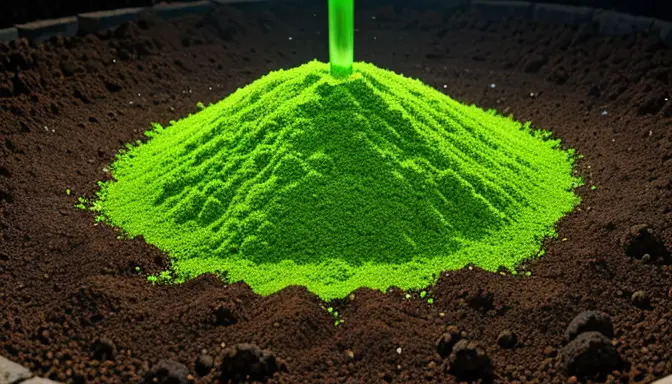
Granular fertilizer is like a hidden treasure chest waiting to be discovered in the world of gardening and agriculture. It holds the power to transform your plants into vibrant, thriving wonders, but its secrets are often shrouded in mystery. Let’s unravel the enigma surrounding granular fertilizer and delve into its wonders, shall we?
Composition of Granular Fertilizer
Granular fertilizer is composed of essential nutrients that are vital for plant growth and development. The primary components of granular fertilizer include nitrogen, phosphorus, and potassium, often referred to as NPK. In addition to these macronutrients, granular fertilizers may also contain secondary nutrients like calcium, magnesium, and sulfur, as well as micronutrients such as iron, zinc, and copper. These nutrients work together to support various aspects of plant health, from root development to flower production.

Release Mechanisms
When it comes to granular fertilizers, understanding their release mechanisms is crucial for ensuring optimal nutrient uptake by plants. These mechanisms determine how and when nutrients are delivered to the soil, influencing the efficiency and effectiveness of the fertilization process.
There are several key release mechanisms employed by granular fertilizers, each with its own unique characteristics and benefits:
- Slow-Release: Slow-release granular fertilizers are designed to gradually release nutrients over an extended period. This method helps prevent nutrient leaching and ensures a steady supply of nutrients to plants, promoting sustained growth and health.
- Controlled-Release: Controlled-release granular fertilizers deliver nutrients at a consistent rate, optimizing absorption by plants and minimizing nutrient loss. These formulations are particularly beneficial for specific plant types that require a steady supply of nutrients over time.
- Water-Activated: Some granular fertilizers release nutrients upon contact with water, ensuring that plants receive immediate nourishment when irrigated. This mechanism is efficient for providing nutrients during watering sessions, promoting rapid plant growth.
By understanding the different release mechanisms of granular fertilizers, gardeners and farmers can choose the most suitable type for their specific needs, ensuring optimal plant nutrition and growth.
Loading... Seconds Left for
Miniature Orchid Terrarium Gallery!

Slow-Release Granular Fertilizers
Slow-release granular fertilizers are a game-changer in the world of plant nutrition.
These fertilizers are designed to provide a steady supply of nutrients to plants over an extended period, ensuring continuous growth and health without the risk of leaching or nutrient wastage..
One of the key benefits of slow-release granular fertilizers is their ability to promote sustainable plant growth by releasing nutrients gradually, mimicking the natural nutrient uptake process of plants.
When it comes to slow-release granular fertilizers, the rate of nutrient release is influenced by various factors such as soil temperature, moisture levels, and microbial activity. This controlled release mechanism allows plants to access nutrients as needed, resulting in efficient absorption and utilization.
By utilizing slow-release granular fertilizers, gardeners and farmers can minimize the frequency of application, reduce the environmental impact of excess nutrients leaching into groundwater, and ensure long-lasting effects on plant health. These fertilizers are a reliable and convenient option for providing plants with essential nutrients without the risk of over-fertilization.
Controlled-Release Granular Fertilizers provide a steady and consistent supply of nutrients to plants, ensuring optimal growth and health. These fertilizers are designed to release nutrients gradually over an extended period, allowing for efficient absorption by plants. The technology behind controlled-release formulations involves coating the granules with a special membrane or layer that regulates the release of nutrients based on environmental factors and plant demand.
Benefits of Controlled-Release Granular Fertilizers:
- Minimize nutrient leaching and runoff, reducing environmental impact
- Optimize nutrient absorption by plants, promoting balanced growth
- Provide long-lasting effects, reducing the frequency of applications
- Enhance nutrient availability for plants, ensuring consistent supply
These
fertilizers are particularly advantageous for crops that require a steady nutrient supply throughout their growth cycle. By delivering nutrients in a controlled manner, these fertilizers help prevent nutrient wastage and ensure efficient utilization by plants, resulting in healthier and more productive crops.
Advantages of Granular Fertilizer
Granular fertilizer offers several advantages over liquid and organic alternatives, making it a popular choice among gardeners and farmers alike. Let’s delve into the benefits of using granular fertilizer:
- Ease of Application: Granular fertilizer is simple to apply, requiring no mixing or special equipment. It can be easily spread by hand or using a spreader, ensuring even distribution.
- Long-Lasting Effects: Due to their slow-release nature, granular fertilizers provide nutrients to plants gradually over an extended period. This results in sustained growth and reduced frequency of application.
- Reduced Runoff: Granular fertilizers are less prone to runoff compared to liquid fertilizers, minimizing the risk of nutrient loss and environmental pollution.
- Precise Nutrient Control: Granular fertilizers allow for precise control over the amount of nutrients applied to the soil, catering to the specific needs of different plants and soil types.

Proper Usage Techniques
Proper usage techniques play a crucial role in maximizing the benefits of granular fertilizer while minimizing potential risks. When applying granular fertilizer, it is essential to consider various factors to ensure optimal results. Here are some key guidelines to follow:
- Calculate the correct dosage based on the specific nutrient requirements of your plants and the nutrient content of the fertilizer.
- Timing is crucial – apply the fertilizer at the right time of the year when plants are actively growing to enhance nutrient uptake.
- Even distribution is essential to avoid nutrient concentration in certain areas and ensure uniform plant growth.
- Avoid over-fertilization, as it can lead to nutrient imbalances, plant stress, and environmental pollution.
- Consider the method of application – broadcasting, banding, or spot application – based on the plant type and soil conditions.
Environmental Impact and Storage Considerations
When it comes to the environmental impact of granular fertilizer, it’s essential to consider its potential effects on the ecosystem. The runoff from excess fertilizer can lead to water pollution, harming aquatic life and disrupting the balance of nutrients in the soil. To mitigate this risk, proper application techniques and dosage control are crucial.
In terms of storage considerations, ensuring the safe and secure storage of granular fertilizer is key to maintaining its effectiveness and preventing any accidents.
Storing fertilizer in a dry, well-ventilated area away from direct sunlight and moisture can help preserve its quality and prevent clumping..
Additionally, keeping fertilizers in their original packaging with proper labeling can prevent mix-ups and ensure safe handling.
ear:both; margin-top:0em; margin-bottom:1em;">See also
Garlic Planting The Perfect Distance for a Raised Bed



